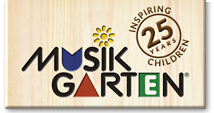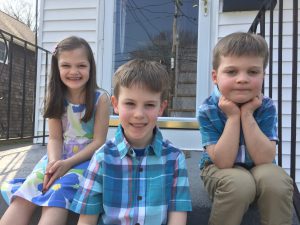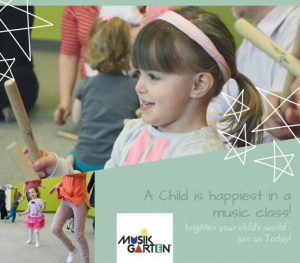Every teacher has a different idea of how they wish to teach through the summer months. Long gone are the days when music studios go quiet during the summer months. Parents are looking for music classes and camp programs to keep their children involved in music. I was curious how different teachers manage their summer months. Last month I spoke about my own way of creating a balance between downtime and offering classes. Here are some other teachers’ responses.
Bobbi Morgan of Florida, who teaches in a studio called Music Compound in Sarasota, Florida tells us about her program:
During the summer I use a variety of Musikgarten programs:
- Babies: Babies Musical World
- Toddlers: Sing/Dance/Play or Clap With Me
- 3s and 4s: Summer (part of the Cycle of Seasons Program)
- 5s: Music Makers at the Seashore
- 6s and 7s: Introduction to Keyboard.
For my Music Makers: at the Keyboard students I also offer a Music Makers Keyboard review class.
Although we have an outdoor space, we tend to not use it because it is simply too hot out there!
I offer my programs through late Spring and Summer. I work most weeks, but I take a break from over the July 4th holiday and most of August. Like many studios, I teach by myself and do my own administrative work, like marketing, registration, collecting tuition and material fees.
To attract families, I have a mailing list to which I email a schedule prior to each session and then I follow up by phone or individual emails. My schedule & Musikgarten information is on the studio web site. I teach a free class for the Hospital Mom/Baby groups. I also put schedules in music stores, children’s clothing stores, church nurseries, doctor’s offices, libraries, coffee shops with bulletin boards, etc.
I teach in the summer because my parents request classes. Teachers in my area who are off in the summer request them too. Short summer classes attract new families, help retain families, and generate income for the studio during dry summer months.
The Toddler classes are most popular, although Baby classes are a close
Second. These classes enable children to participate in group experiences
before preschool years begin. It gives the moms something to do together
with their child and friends with kids. They believe in the power of music
to facilitate their child’s development. Everything is new & exciting
to this age group. To new teachers I just want to mention that attendance to summer classes in my area is generally sporadic, unlike during the rest of the year.
Lianne Brewer founded The Music Factory in Springfield, IL in 1994, and currently has 7 teachers serving approximately 300+ children. She now lives in southern CA and has started teaching Musikgarten there at a local music school. This is how Lianne is shaping up her summer plans:
I use the Musikgarten curriculum because everything I need is there! I love teaching Musikgarten because the curriculum excels in providing developmentally appropriate activities, as well as fun activities, melodious songs, and lots of variety for the families and for me. The music school I presently teach at has no access to outdoor space, but many years ago I did have a grassy area outside that we used in the preschool classes! Great fun!
Currently I teach a summer program by myself (looking for another teacher and helper!) for six weeks during the summer starting in early June when school is out. In previous summers my teaching colleagues and I have presented a program called “A Taste of Music”. This ran for two weeks in August and was a music program filled with fun, low-key classes that geared up for Fall. We made a rule that current families could only attend if they brought a NEW family. These August classes were FREE!
To find families, I advertise on Facebook, and direct email. I primarily teach during summer to attract new families, so I make the session shorter to give families a taste of my regular programs.
In my present music school my most popular class has been our Dancing, Drumming & Drawing Camps for preschool (ages 3-5 yrs) and music makers (ages 6-8). Offered 1x a week, on two different days, from 9:30-11:45 AM, for 6 weeks. I am lucky because I can offer a Baby Class or a Toddler class at the same time in another room. Of all the summer toddler programs, Twist and Turn or Nimble and Quick have been the most popular.
I would encourage teachers to offer “perks” to get new families in! It works to offer discounts to current families if they bring a new family; I also have families pay for only classes they can attend (minimum of 4 out of 6 weeks) so those who say they can’t come at all because they’ll miss two classes due to vacation, swimming lesson, etc, will be more inclined to come!
Stephanie Rivera, Coordinator of Children’s Music at First Presbyterian Church Orlando, has big plans for the summer:
We use the following programs during the summer.
Summer Curriculum plans for 2017:
- Babies (birth-13 months) – My Musical World
- Walkers (14-23 months) – My Day
- Toddlers (2-3 yrs) – On a Trip
- Big Kids (3-4 yrs) – Cycles Summer
- Family Class (mixed ages) – Nature’s Music
- Explorers (4-5 yrs) – My Neighborhood Community
- World Travelers (5-6 yrs) – Seashore
- Nature Trail for 6-8 yrs, possibly
We solely use Musikgarten as our curriculum because of it’s quality, flexibility, and how many curriculum options we have for our large program.
Our location is a church in a downtown area. It has 3 buildings and a parking garage, which can be intimidating to some families.
Our summer schedule usually consists of morning classes Tuesday-Thursday, adding Friday as necessary. Very rarely add Mondays, but it has happened. We also offer a lunch-time class, but that has a tendency to be cancelled because it is such an odd time. We take off the week of July 4th, and this summer will also take off the week our church has Vacation Bible School due to lack of rooms available.
I have a team of 4-6 teachers that teach during the year, and a small set of 2 teachers that teach during the summer. This summer, I’ll teach on my own due to one teacher being on maternity leave and the other traveling more this summer than usual.
We use Facebook for our advertising through our own Facebook page and my own personal page. Our teachers share my posts about upcoming classes. Current families also tag their friends in the comments. The rest is word-of-mouth. In May, I will give a free demo to a local moms group in hopes that they will join us for Summer.
Our most popular classes during the summer are Walkers and Toddlers. There are many activities available for 3 years-old and older in our area, and some people think their baby is “too young” to attend classes so they wait until they are walking to pursue any structured activities.
When offering summer activities, consider that many people are traveling during the summer, so try to keep your classes in the middle of the week rather than Monday or Friday. As always, nap time is a major factor when families are scheduling activities, so ask around about what ages are napping and what time of day. Mixed ages classes work well during the summer due to older siblings being out of school, so that might be a good starting point of your curriculum offerings.
I hope these three teachers give you some great ideas! What are you planning to do this summer?








